
A cactus is a member of the plant family Cactaceae, a family comprising about 127 genera with some 1750 known species of the order Caryophyllales. The word cactus derives, through Latin, from the Ancient Greek word κάκτος (káktos), a name originally used by Theophrastus for a spiny plant whose identity is now not certain. Cacti occur in a wide range of shapes and sizes. Although some species live in quite humid environments, most cacti live in habitats subject to at least some drought. Many live in extremely dry environments, even being found in the Atacama Desert, one of the driest places on Earth. Because of this, cacti show many adaptations to conserve water. For example, almost all cacti are succulents, meaning they have thickened, fleshy parts adapted to store water. Unlike many other succulents, the stem is the only part of most cacti where this vital process takes place. Most species of cacti have lost true leaves, retaining only spines, which are highly modified leaves. As well as defending against herbivores, spines help prevent water loss by reducing air flow close to the cactus and providing some shade. In the absence of true leaves, cacti's enlarged stems carry out photosynthesis. Cacti are native to the Americas, ranging from Patagonia in the south to parts of western Canada in the north—except for Rhipsalis baccifera, which also grows in Africa and Sri Lanka.
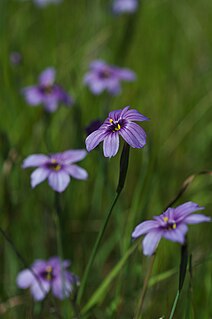
Sisyrinchium bellum, the western blue-eyed grass or Californian blue-eyed grass, is the common blue-eyed grass of California and Oregon in and west of the Sierra Nevada, its range extending south into Baja California. In parts of its range, western blue-eyed grass has previously been classified as Sisyrinchium eastwoodiae, S. greenei and S. hesperium, but these names are now considered synonyms.

A perennial plant or simply perennial is a plant that lives more than two years. The term is often used to differentiate a plant from shorter-lived annuals and biennials. The term is also widely used to distinguish plants with little or no woody growth from trees and shrubs, which are also technically perennials.

Coincya wrightii, known as Lundy cabbage, is a species of primitive brassicoid, endemic to the island of Lundy off the southwestern coast of England, where it is sufficiently isolated to have formed its own species, with its endemic insect pollinators. Coincya wrightii grows natively only on the eastern cliffs and slopes of the island and nowhere else in the world and is a protected species. It reaches up to a metre in height and with its yellow flowers it looks a little similar to oil seed rape. Although it is a member of the cabbage family, it tastes unpleasant – it has been described as "triple-distilled essence of Brussels sprout".

Holcus lanatus is a perennial grass. The specific epithet lanatus is Latin for 'woolly' which describes the plant's hairy texture. Common names include Yorkshire fog, tufted grass, and meadow soft grass. In North America, where it is an invasive species, names include velvet grass and common velvet grass.

Cylindropuntia imbricata, the cane cholla, is a cactus found in the Southwestern United States and northern Mexico, including some cooler regions in comparison to many other cacti. It occurs primarily in the arid regions of the Southwestern United States in the states of Kansas, Oklahoma, Texas, New Mexico, Arizona, Colorado, and Nevada. It is often conspicuous because of its shrubby or even tree-like size, its silhouette, and its long-lasting yellowish fruits.
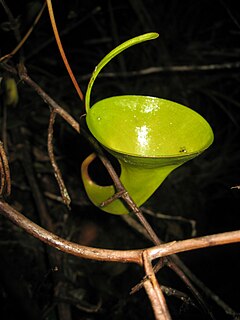
Nepenthes inermis is a tropical pitcher plant endemic to the Indonesian island of Sumatra. The specific epithet inermis is Latin for "unarmed" and refers to the upper pitchers of this species, which are unique in that they completely lack a peristome.

Neotinea ustulata, the burnt orchid or burnt-tip orchid, is a European terrestrial orchid native to mountains in central and southern Europe, growing at up to 2,400 m (7,900 ft) elevation. The plant is considered Endangered in Great Britain and Least Concern internationally based on IUCN Red List criteria. The burnt-tip orchid was voted the county flower of Wiltshire in 2002 following a poll by the wild flora conservation charity Plantlife.

Alsophila dregei, synonym Cyathea dregei, is a widespread species of tree fern in southern Africa.

Bambusa vulgaris, common bamboo, is an open-clump type bamboo species. It is native to Indochina and to the province of Yunnan in southern China, but it has been widely cultivated in many other places and has become naturalized in several regions. Among bamboo species, it is one of the largest and most easily recognized.
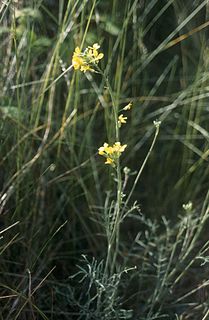
Coincya is a genus of flowering plant that belongs to the family Brassicaceae. Three species of the plant are endemic to the British Isles, these being Coincya wrightii, Coincya cheiranthos (nokkasinapit) and Coincya monensis, which has two subspecies, C. monensis subsp. monensis and C. monensis subsp. recurvata. Another four species are endangered and endemic to the south-central Iberian peninsula.

Digitalis thapsi, which has been called mullein foxglove in the US, is a flowering plant in the genus Digitalis that is endemic to the Iberian Peninsula, where it occurs in eastern Portugal and central and western Spain. It is of commercial importance as an ornamental plant. Hybrids with D. purpurea have proved successful and are fertile.
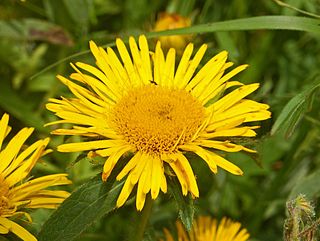
Pentanema hirtum is a species of perennial herbaceous plant belonging to the family Asteraceae. The specific Latin name hirtum refers to the type of hairiness of the plant.

Coincya monensis is a plant species in the family Brassicaceae. Coincya monensis is native to western Europe and Morocco, but has been introduced in North America.
Coincya cintrana is a flowering plant of the family Brassicaceae. It is a hemicryptophyte plant, and it grows on walls, in steep areas and in rocky slopes. It flowers from April until June.

The flora of the U.S. Sierra Nevada alpine zone is characterized by small, low growing, cushion and mat forming plants that can survive the harsh conditions in the high-altitude alpine zone above the timber line. These flora often occur in alpine fell-fields. The Sierra Nevada alpine zone lacks a dominant plant species that characterizes it, so may or may not be called a vegetation type. But it is found above the subalpine forest, which is the highest in a succession of recognized vegetation types at increasing elevations.
Psylliodes luridipennis, commonly known as the Lundy cabbage flea beetle or the bronze Lundy cabbage flea beetle, is a species of flea beetle endemic to the island of Lundy, where it lives and feeds upon the endemic Lundy cabbage. Along with the true weevil Ceutorhynchus contractus var. pallipes and an undescribed race of flea beetle Psylliodes napi, it is known only from the Lundy cabbage. The species was first recorded by Thomas Vernon Wollaston in the 1840s, and was named by the Austrian entomologist Franz Kutschera in 1864.
Iris dolichosiphon is a plant species in the genus Iris, it is also in the subgenus Iris and in the section Pseudoregelia. It is a rhizomatous perennial, from China and Bhutan. It has long, thin dark green leaves, very short stem, and dark blue, purple, or violet flowers. That are mottled with white. It has thick white/orange beards. It has one subspecies, Iris dolichosiphon subsp. orientalis, from China, India and Burma. It has similar flowers. They are cultivated as ornamental plants in temperate regions
Iris taochia is a plant species in the genus Iris, it is also in the subgenus Iris. It is a rhizomatous perennial, from the Caucasus mountains and Turkey. It forms dense clumps, with grey-green leaves, simple stems of similar height, with 1–3 branches, a flowers in various shades from white, yellow to purple. They also have yellowish or white, tipped yellow beard. It is cultivated as an ornamental plant in temperate regions.
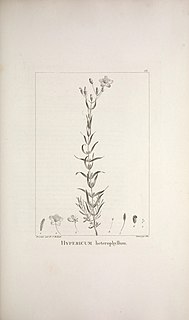
Hypericum heterophyllum is a flowering plant in the Hypericaceae family and is the only species in Hypericum sect. Heterophylla.

















